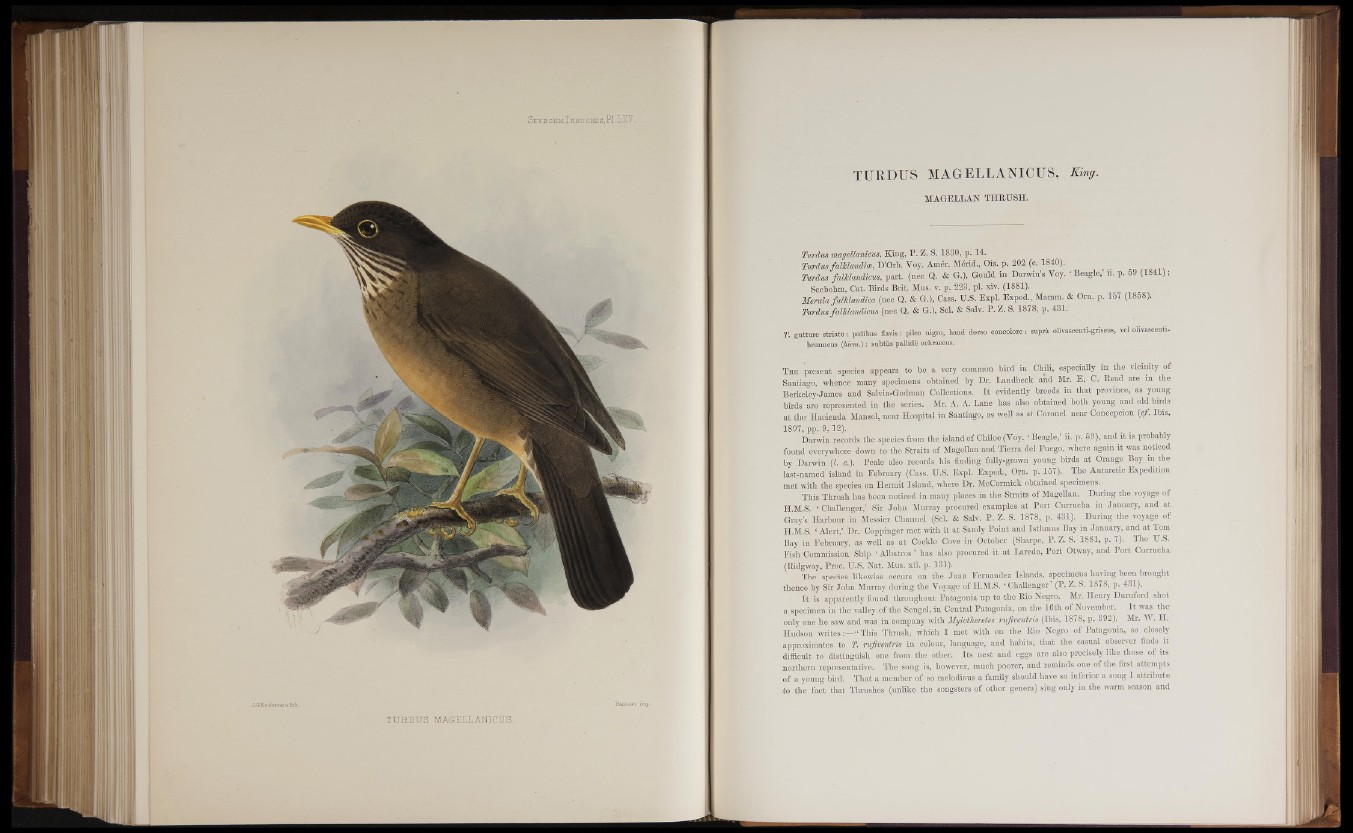
i l t t i i MAGELLAN! C IJS.
TUKDUS MAGELLANICUS, King.
MAGELLAN THBUSH.
Turdus mageltanicus, King, P. Z. S. 1830, p. 14.
Turdus falJclandice, D’Orb. Voy. Amer. Merid., Ois. p. 202 (c. 1840).
Turdus faljclandicus, part, (nec Q. & G.), Gonld in Darwin’s Voy. ‘ Beagle,’ n. p. 59 (1841);
Seebohm, Cat. Birds Brit. Mus. v. p. 223, pi. xiv. (1881).
Merula falltlandica (nec Q. & G.), Cass. U.S. Expl. Exped., Mamm. & Om. p. 157 (1858).
Turdus falklandicus (neo Q. & G.), Scl. & Salv. P. Z. S. 1878, p. 431.
T. guttare stria to : pedibus flavis: pileo nigro, baud dorso concolore: supra olivascenti-griseus, vel ohvascenti-
brunneus [Mem.): subtus pallid^ ocbraceus.
The present species appears to be a very common bird in Chili, especially m the vicinity of
Santiago, whence many specimens obtained by Dr. Landbeck and Mr. E. C. Bead are in the
Berkeley-James and Salvin-Godman Collections. It evidently breeds in that province, as young
birds are represented in the series. Mr. A. A. Lane has .also obtained both young and old birds
at the Hacienda Mansel, near Hospital in Santiago, as well as at Coronel near Concepcion (cf. Ibis,
1897, pp. 9,12).
Darwin records the species from the island of Chiloe (Yoy. ‘Beagle, ii. p. 59), and it is probab y
found everywhere down to the Straits of Magellan and Tierra del Fuego, where again it was noticed
by Darwin (I. c.). Peale also records his finding fully-grown young birds at Orange Bay in the
last-named island in February (Cass. U.S. Expl. Exped., Orn. p. 157). The Antarctic Expedition
met with the species on Hermit Island, where Dr. McCormick obtained specimens.
This Thrush has been noticed in many places in the Straits of Magellan. During thevoyage of
H.M.S. -‘ Challenger,’ Sir John Murray procured examples, at Port Currucha in January, and at
Gray’s,. Harbour in Messier Channel (Scl. & Salv. P. Z. S. 1878, p. 431). During the voyage of
H.M.S. ‘Alert,’ Dr. Coppinger met with it at Sandy Point and Isthmus Bay in January, and at Tom
Bay in February, as well as at Cockle Cove in October (Sharpe, P. Z. S. 1881, p. 7). The U.S.
Fish Commission Ship ‘Albatros’ has also procured it at Laredo, Port Otway, and Port Currucha
(Bidgway, Froc. U.S. Nat. Mus. xii. p. 131).
The species likewise occurs on the Juan Fernandez Islands, specimens having been brought
thence by Sir John Murray during the Voyage of H.M.S. ‘ Challenger’ (P. Z. S. 1878, p. 431).
It is apparently found throughout Patagonia up to the Bio Negro. Mr. Henry Durnford shot
a specimen in the valley of the Senge], in Central Patagonia, on the 16th of November. It was the
only one he saw and was. in. company with Myiotheretes rujiventris (Ibis, 1878, p. 392). Mr. W. H.
Hudson writes:—“ This Thrush, which, I met with on the Bio Negro of Patagonia, so closely
approximates to T. rujiventris in .[colour, language, and habits, that the casual observer finds it
difficult to distinguish one from the . other. Its nest and eggs are also precisely lik e those of its
northern representative. The song is, however, much poorer, and reminds one of the first attempts
of a young bird. That a member of. so melodious a family should have so inferior a song I attribute
•to the fact that Thrushes (unlike the songsters of other genera) sing only in the warm season and